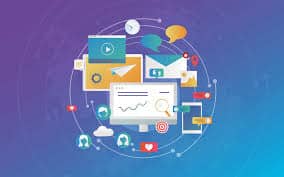Channel marketing is a great strategy to use, but for it to be successful, you must be ready to overcome the obstacles. Each channel has the potential to reach more people, engage different audiences, and deal with various challenges. It will take time and effort to develop a successful strategy, but the results could be very rewarding. So in this article, we will be talking about all you need for channel marketing, mostly the strategies.
What is Channel Marketing
The practice of channel marketing entails having other parties (either individuals or businesses) sell your goods or service. Consider the case of a SaaS software provider with a fresh sales CRM. Working with channel partners who specialize in creating bespoke IT solutions may allow you to resell your CRM as one of the products they incorporate into their offerings.
Simply promoting your product through advertising and marketing channels is not channel marketing. When you have multiple channel partners, you have multiple separate companies selling the same product because channel partners are frequently businesses in and of themselves.
What Advantages does Channel Marketing Offer?
While some benefits, like selling in more locations, are obvious, channel marketing benefits go beyond this. Here are five of the most typical ones.
#1. Reaches Customers who are Ready to Make a Purchase.
If you don’t let clients know about your goods who are likely to buy them, a sale won’t happen. Continuing the previous example, when artisanal pickles are sold through gourmet food stores, the product is presented to buyers who probably have a high purpose to buy specialty foods. The pickle manufacturer may collaborate with upmarket, local grocery store chains that sell both artisanal goods and major brands to reach a potentially bigger population of target consumers.
#2. Reduces Costs by Providing
Return on investment can be increased by reducing cost per acquisition (the total cost to acquire a paying customer) (ROI). When channel partners handle your consumer-facing advertising and marketing on your behalf, channel marketing can lower your CPA. Without a doubt, channel marketing costs have an impact on ROI. Nevertheless, compared to the serviceable attainable market, the pool of prospective channel partners you need to advertise to will be significantly smaller (SOM).
#3. Increases Awareness of the Brand
In our contemporary marketplace, competing companies compete for the attention of the same audience. It might be difficult to build brand recognition so that consumers can distinguish your brand from rival brands. Nonetheless, it is crucial since, in the end, brand recognition leads to brand awareness, when the general public recalls details and opinions about your company. Sales are typically increased as a result.
#4. More Comprehensive Information about Your Consumers is Provided
Channel partners frequently have better access to your market and the people who buy your product than you do. In this situation, channels ought to give you more in-depth knowledge about your target audience and the customer experience than you might discover on your own.
Let’s imagine that the gourmet stores that sell your pickles have a loyal clientele that is willing to give the store’s items their honest opinion. You should receive this information from the stores so that you may learn how to improve the attraction of your goods and increase sales. For instance, you might decide to expand your product line with hot and spicy pickles if your channel partners are telling you that their customers would love a spicier version of your pickles.
#5. Develops Client Trust
In the market of today, where purchasers are inundated with options, the power of trust is more potent than ever. Which one would you pick if you had an option between two comparable products with comparable prices, one from an unreliable brand and the other from one you respect? Reliable channel partners who represent a well-known brand automatically give their clients more confidence in your product. It has earned the faith of others. This associational trust will grow over time, and your brand will start to gain its own trust.
How to Create a Channel Marketing Plan that Works
You must decide which channel marketing model will best serve your company’s goals and objectives as you begin your channel marketing journey, as well as which marketing channels are appropriate for your organization and its goods and services. Not every marketing strategy will be effective for your company. If you lack the necessary personnel or your present product marketing team lacks channel marketing expertise,
The following are seven crucial factors to take into account when creating your channel marketing strategy and choosing the most effective marketing channels.
#1. Create a Marketing Strategy
Without a clear plan, even the best ideas risk failing. Although it might seem apparent, establish your marketing strategy from the ground up or revisit an existing one to determine how, where, when, and why channel marketing fits in. Establish the qualities you look for in a channel partner. Sort out the essentials from the nice-to-haves and determine which features are most likely to make customers notice your message and result in a sale. Make sure to specify how a channel partner should interact with customers at each level of the buying process, from awareness to purchase intent to taking action.
#2. Know the Shopping Preferences of Your Target Market(s)
With this information, you can decide whether or not channel marketing will be effective with your target audience. Conduct stakeholder interviews or focus groups to gain understanding if you’re unsure. Yes, these Before making a substantial change to your marketing approach, it’s imperative to understand your audience, even though it takes time and money to do so.
#3. Analyze Your Available Time and Resources for Channel Marketing
The time and resources needed to find suitable channel partners, influence them, negotiate contracts with them, and then manage, nurture, and engage them on an ongoing basis must be calculated. Ask yourself, “What can I give a new partner? and decide what justifies putting money into a relationship with you. Can you offer sufficient assistance? Your potential channel partner will be interested in the specifics. You must have solutions on hand.
#4. More Comprehensive Information about Your Consumers is Provided.
Channel partners frequently have better access to your market and the people who buy your product than you do. In this situation, channels ought to give you more in-depth knowledge about your target audience and the customer experience than you might discover on your own.
Let’s imagine that the gourmet stores that sell your pickles have a loyal clientele that is willing to give the store’s items their honest opinion. You should receive this information from the stores so that you may learn how to improve the attraction of your goods and increase sales. For instance, you might decide to expand your product line with hot and spicy pickles if your channel partners are telling you that their customers would love a spicier version of your pickles.
#5. Develop Client Trust
In the market of today, where purchasers are inundated with options, the power of trust is more potent than ever. Which one would you pick if you had an option between two comparable products with comparable prices, one from an unreliable brand and the other from one you respect? Reliable channel partners who represent a well-known brand automatically give their clients more confidence in your product. It has earned the faith of others. This associational trust will grow over time, and your brand will start to gain its trust.
Types of Channels Marketing
#1. Cheap Marketing Methods
This group includes marketing channels that are available for free.
You only need to invest your time to create and carry out a marketing strategy using a free channel. You will engage more resources, such as money, in free marketing channels if you hire pros to assist with the marketing.
#2. Paid Advertising Media
As the name suggests, this marketing channel includes marketing platforms that you pay a fee to access or utilize to promote your brand. Paid advertisements, advertising, and influencer marketing are a few examples. Keep in mind that some marketing avenues might naturally be both free and paid. For instance, Twitter advertising cost money even though the service is free to use. Consider using sponsored advertisements by using this promoted post from Bridgecrew on Twitter as an example.
#3. Channels for Digital Marketing
Digital marketing refers to any form of online advertising.
Social media, organic search (SEO), paid search, blogs, emails, and video marketing are a few of the top marketing channels that fall under the category of digital marketing.
Digital marketing is well-exemplified by the Australian cosmetics company Frank Body.
Frank Body gained popularity using Facebook and Instagram with less than a $10,000 starting budget.
The founders developed a witty brand persona that connected with their target market, increased their social media presence, and then used user-generated content (UGC) to spur additional growth on the same marketing channels.
#4. Channels of Traditional Marketing
Traditional marketing is any advertising that isn’t done online.
Direct mail, broadcast, print, and outdoor advertising such as billboards are examples of traditional marketing methods.
You can interact with a variety of local customers through traditional marketing. While digital marketing platforms are increasingly congested, it also allows you more control over your marketing message and aid in better grabbing the attention of your customers. Marketers believe that traditional marketing will soon experience growth.
#5. Sites and Blogs
A website serves as the online headquarters for your company. In contrast, a blog is a consistent online publication that marketers may use to their advantage to inform or educate their target audience.
According to 1 in 5 bloggers, blogging helps them achieve “strong results.” They include attracting additional customers to their company, nurturing leads, and converting.
For instance, the creator of Backlinko, Brian Dean, employed blogging to increase organic traffic. He developed detailed blog content using the skyscraper strategy, which increased his traffic and resulted in backlinks.
Channel Marketing Strategy
Here are few best practices to take into account if your business is prepared to take its channel marketing plan seriously:
#1. Recognize Your Audience’s Preferences and Choose Channels Accordingly
We cannot stress this enough: choosing the channels that your audience uses the most is an essential component of a channel strategy. Before moving forward, you must understand your target audience and the channels they are already watching and using.
#2. Do Not Overextend Yourself
Up until about a year and a half ago, Ho-Ho-Kus, New Jersey-based Powersolution.com, which provides IT support and managed services, adopted an entirely hands-off approach to its channel marketing strategy. Since then, it has recruited an outside company that specializes in marketing for IT professionals. Its justification was driven by a shortage of internal resources. Powersolution.com terminated the contract four months later since not a single sales lead was generated, according to Dina Dadian, vice president of online operations at Powersolution.com.
#3. Adapt Your Channels to the Needs of the Customer
So don’t only think about the areas that your customers use the most. Consider your audience’s wants and how you may position yourself to meet them by strategically choosing outlets.
How does each channel fit into your broader branding and marketing strategies, and how can they individually help persuade your audience to purchase from you?
For instance, if you run an online and offline teen apparel business, you’ll undoubtedly employ influencer marketing, Instagram campaigns, and word-of-mouth advertising as your main marketing platforms. Of course, you’ll also want to optimize your website to promote new products and make it simple to use your online store.
#4. Establish Objectives for Every Channel You Use
Setting quantifiable objectives can help you gauge how well your channel marketing plan is working after you’ve decided which channels to concentrate on. Depending on where each channel falls into the buyer’s journey, each will probably have a different primary goal or goals. Also, as long as each goal is measurable, you are permitted to specify more than one goal for a channel.
Cross Channel Marketing
Cross-channel marketing combines different marketing channels to give your target audience a more seamless customer journey. To establish a connected message that flows from one to the other, channels should cooperate. Marketers can use people-based marketing to develop thorough profiles of consumers by interacting with them at many touchpoints, helping to customize the customer experience and fostering loyalty.
What Makes Cross-Channel Marketing Effective?
Consumers may be reached and engaged in more ways than ever now, and marketers can gain deeper insights by using a complete approach that takes into account every channel. The following are a few major advantages of cross-channel marketing:
#1. Improve the Customer Experience
A comprehensive approach to the customer journey has a big impact. It has been demonstrated that by properly attributing marketing approaches to client behaviors or impact, comprehensive, cross-channel campaigns can increase marketing budget efficiencies by 15 to 20 percent. In addition, a study of 46,000 people found that 73% of consumers use multiple channels to make purchases.
#2. Higher Engagement
Customers that engage with retailers across 10 or more channels are incredibly valuable to your brand; according to the report, 62 percent of these customers make purchases once a week or more. Engaging interactions help create emotional ties between consumers and brands, which are frequently the determining factors in converting your target market to brand-loyal customers.
#3. Develop a Powerful Brand to Foster Better Connections
You gain more awareness through several channels, which helps you build a stronger brand and increase consumer loyalty. Take Apple as an example: They have physical stores, a straightforward website, TV advertisements, and digital ads. They can keep a similar look and message at every touchpoint by adhering to a consistent brand and style guide.
Making a Successful Cross-Channel Marketing Campaign: Some Suggestions
Cross-channel marketing aims to give clients unique and interesting experiences. When creating a campaign, bear the following in mind:
#1. Increase the Use of Data-Driven Decision-Making
Organizations need to be data-driven to create a successful campaign. They must take into account their target market’s demographics, preferred platforms, and preferred types of messaging. High-quality data collected from various channels will reveal behavioral trends and patterns that may be utilized to contextualize the preferences and choices of your audience.
#2. Aggregate and Person-Level Data are Used to Create Customer Personas
Detailed customer profiles can provide you with a deeper understanding of what and who your target audience is already engaging with as well as their motivations and purchasing patterns. You can discover segments within your audience by combining consumer data that is aggregated and that that is collected at the individual level. To achieve recurring success, these insights can then be leveraged to inform the next tactics and messages.
#3. Establish Distinct Job Descriptions and a Designated Leadership Role
According to a Gartner poll on marketing effectiveness, 60 percent of the firms who said they were outperforming their competitors had a leadership position solely devoted to multi-channel marketing. Nearly all survey participants claimed they have someone in charge of multi-channel marketing who holds a director position or higher, according to the same poll. Almost 30% of CMOs are in charge of this task, while 56% of respondents work directly for the C-suite.
Omni Channel Marketing
The term “omnichannel marketing” describes a company’s presence across several channels. Together with offline channels like brick-and-mortar retail stores or company events, these channels can also include websites, apps, social media, and email.
Today’s consumers want to interact with your brand 24 hours a day, seven days a week, through stores, applications, and mobile devices. Additionally, they anticipate that your business communications will be up-to-date about their preferences and purchases. By assisting a company in presenting a consistent, educated message to provide a seamless experience over many channels, omnichannel marketing meets this market requirement and enhances both the overall buyer journey and customer retention.
- These are some instances of omnichannel marketing in action:
#1. Omnichannel Advertising for a Jewelry Business
A jewelry store emails its clientele to alert them to the arrival of a print catalog of the newest collection in their mailbox. The shop’s catalog directs customers to both its physical presence and its online store.
#2. A craft Store’s Omnichannel Marketing
Facebook posts from a craft store promote YouTube DIY instructions for entertaining family projects. The films encourage viewers to join the chain’s email list so they can get updates on new videos and a list of the materials required for the crafts, along with convenient links back to the main website to make purchases.
#3. Multichannel Advertising for a Restaurant in Italy
A restaurant in Italy encourages customers to join its loyalty program. They receive a personalized welcome email from the management of the location they visited the day after joining, along with an invitation to download the program’s mobile app. They will get a free appetizer with their subsequent meal as a thank-you for logging in.
Multiple Channel Marketing
Multi-channel marketing combines numerous channels for distribution and promotion into a single, cohesive plan to draw clients. This strategy utilizes the distinctive advantages of particular marketing channels to effectively and efficiently communicate the value of a product or service. Email, direct mail, websites, social media, display ads, and/or a physical storefront are just a few examples of these channels.
Multi-channel marketing has long been praised by marketers. According to one study, multi-channel customers spend two to five times as much as single-channel customers. Now, let’s show why multichannel marketing tactics are deserving of this reputation.
#1. Enhanced Range
Marketers boost their reach among members of their potential audience when they extend their marketing efforts to additional channels. Customers with untapped purchasing potential can be found by expanding your efforts to include new channels because many customers only interact on a small number of channels.
#2. Higher Engagement
More consumer touchpoints are frequently created by expanding the number of channels. This not only increases consumer interaction with companies but also creates new channels of communication between the company and the client.
What is the Role of Channel Marketing?
A channel marketing manager develops marketing campaigns to advertise goods and services through particular media. You can think about pursuing a career as a channel marketing manager if you like learning about the most recent digital trends, doing data analysis, and coming up with innovative ways to advertise things.
What are the 4 Channels of Distribution?
A distribution channel is a network of businesses or middlemen that the final consumer uses to buy goods or services here are examples of distribution channels.
- Wholesalers,
- Retailers,
- Distributors
- and the Internet
What is Channel Marketing Structure?
the process by which a delivery chain’s network of participating intermediaries is built to carry out the necessary tasks to fulfill the distribution aims and objectives of an organization.
What are the benefits of Channel Marketing?
- Get the trust of your customers. …
- Obtain more prospects. …
- Improve the targeting. …
- Better consumer data collection. …
- See your ROI more quickly. …
- Heighten the awareness of your brand. …
- Spread out your clientele.
Advantages and Disadvantages of Channel Marketing What are they?
- Advantages: they are typically inexpensive to produce; they engage your audience with your business; they actively reinforce your main themes and branding; they provide common information with ease.
- Disadvantages: It’s challenging to target certain demographics and calculate ROI (return on investment).
What are the 5 Roles of Channel Marketing?
The following general tasks are carried out by marketing channels:
- Gathering market data,
- Boosting demand,
- Carrying inventories,
- Physically distributing goods, enabling transactions, and
- Offering after-sale services.
Conclusion
They make it possible for your company to communicate with customers seamlessly, increasing the number of individuals you can reach and raising awareness of your goods and services. The following reasons make marketing channels crucial: They help determine the most effective ways to reach a target demographic.
Related Articles
- CHANNEL MANAGEMENT: Meaning, Examples & Why It Is Important
- WHAT IS A CHANNEL? Types of Distribution Channel
- DIGITAL MARKETING CHANNELS: Most Effective Digital Marketing Channels for Your Business
- MARKETING CHANNELS: Top 10 Digital Marketing Channels
- HOW TO START A YOUTUBE CHANNEL: Step by step Guide
References
- triptych.com
- upwork.com
- cochedule.com
- referralrock.com
- activecampaign.com






